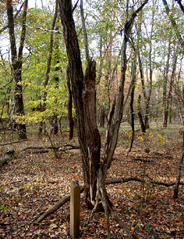|
#3
Even though this forest is certainly not considered "old
growth," there is a large amount of dead woody debris here.
Trees die for a variety of reaso ns,
including disease, and insect and storm damage. In addition, wind
frequently prunes dead branches from an otherwise live tree. Bacteria,
fungi and insects quickly attack all of this woody debris
on the forest floor. These organisms absorb nutrients that had
previously been locked up in wood, recycling them back into the
forest food chain. Dead branches also provide structural diversity
to the forest, providing shelter to animals like salamanders,
sowbugs and worms. Trees that die but remain upright are called
snags. Snags do begin to decay as bacteria, insects and fungi
colonize the upright trunk, but the rate is comparatively
slow. Snags are especially valuable as nest sites for owls and
flying squirrels, and woodpeckers, creepers and other gleaning
birds profit from the rich lode of insects. Although we humans
tend to view logs, branches and snags as untidy, they are very
important to the ecology of a forest. ns,
including disease, and insect and storm damage. In addition, wind
frequently prunes dead branches from an otherwise live tree. Bacteria,
fungi and insects quickly attack all of this woody debris
on the forest floor. These organisms absorb nutrients that had
previously been locked up in wood, recycling them back into the
forest food chain. Dead branches also provide structural diversity
to the forest, providing shelter to animals like salamanders,
sowbugs and worms. Trees that die but remain upright are called
snags. Snags do begin to decay as bacteria, insects and fungi
colonize the upright trunk, but the rate is comparatively
slow. Snags are especially valuable as nest sites for owls and
flying squirrels, and woodpeckers, creepers and other gleaning
birds profit from the rich lode of insects. Although we humans
tend to view logs, branches and snags as untidy, they are very
important to the ecology of a forest.
|











